Effect of plant density and hand weeding on weed control and yield of the vegetable corn
Weed infestation has an adverse impact on the yield of vegetable
corn. This study, therefore, aimed to investigate the effects of plant
density and hand weeding on controlling weeds and yield of
vegetable corn. The experiments were conducted in the field
condition in a randomized complete block design with three
replications. The planting densities were 79,365 plants ha-1 (D1);
92,593 plants ha-1 (D2); 111,111 plants ha-1 (D3); and 138,889 plants
ha-1 (D4). The hand weeding treatments were no weeding (NW), hand
weeding once at 3-4 leaf stage of vegetable corn (HW1), and hand
weeding twice at 3-4 leaf and 8-9 leaf stages of vegetable corn
(HW2). The results showed that the highest planting density
combined with hand weeding was generally effective in controlling
weeds. Furthermore, the increase in planting density combined with
hand weeding significantly improved the physiological traits, which
consequently increased the cob yield. The yield was optimum at D3
combined with hand weeding once. Thus, the results suggested that
the optimum yield of vegetable corn could be obtained at a planting
density of 111,111 plants ha-1 combined with hand weeding once at
3-4 leaf stage, an increase of the cob yield by 2.01 tons ha-1.
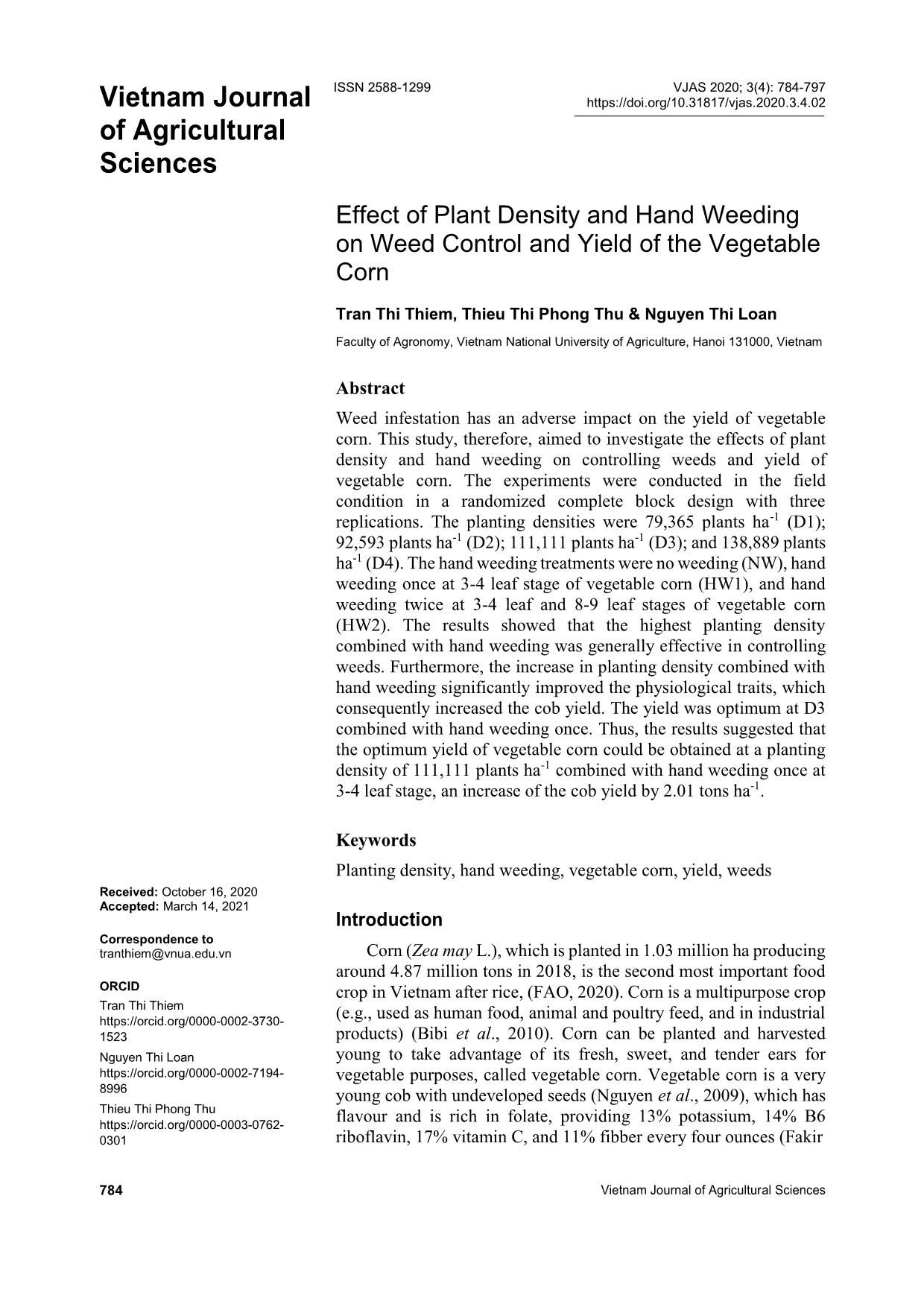
Trang 1
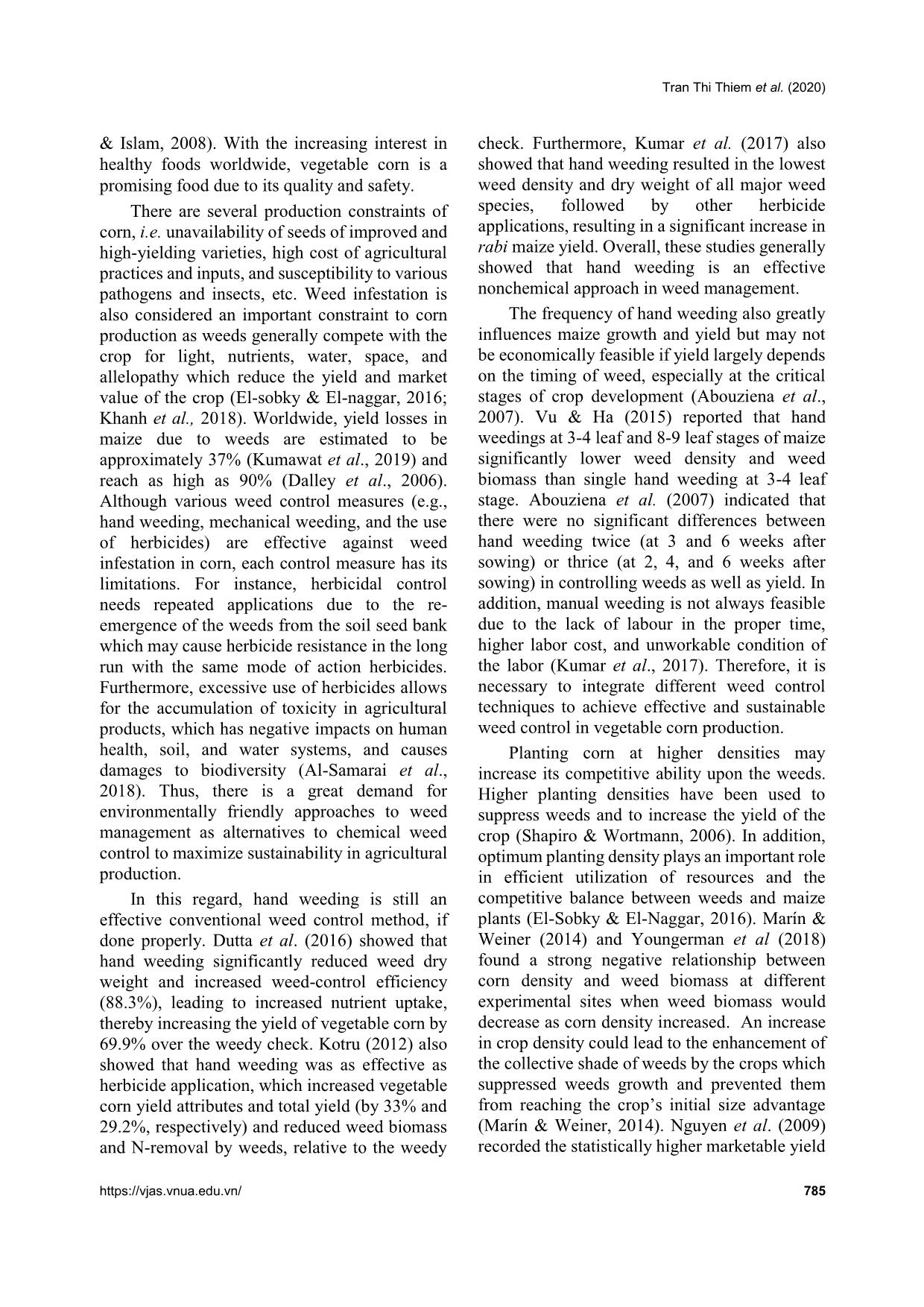
Trang 2
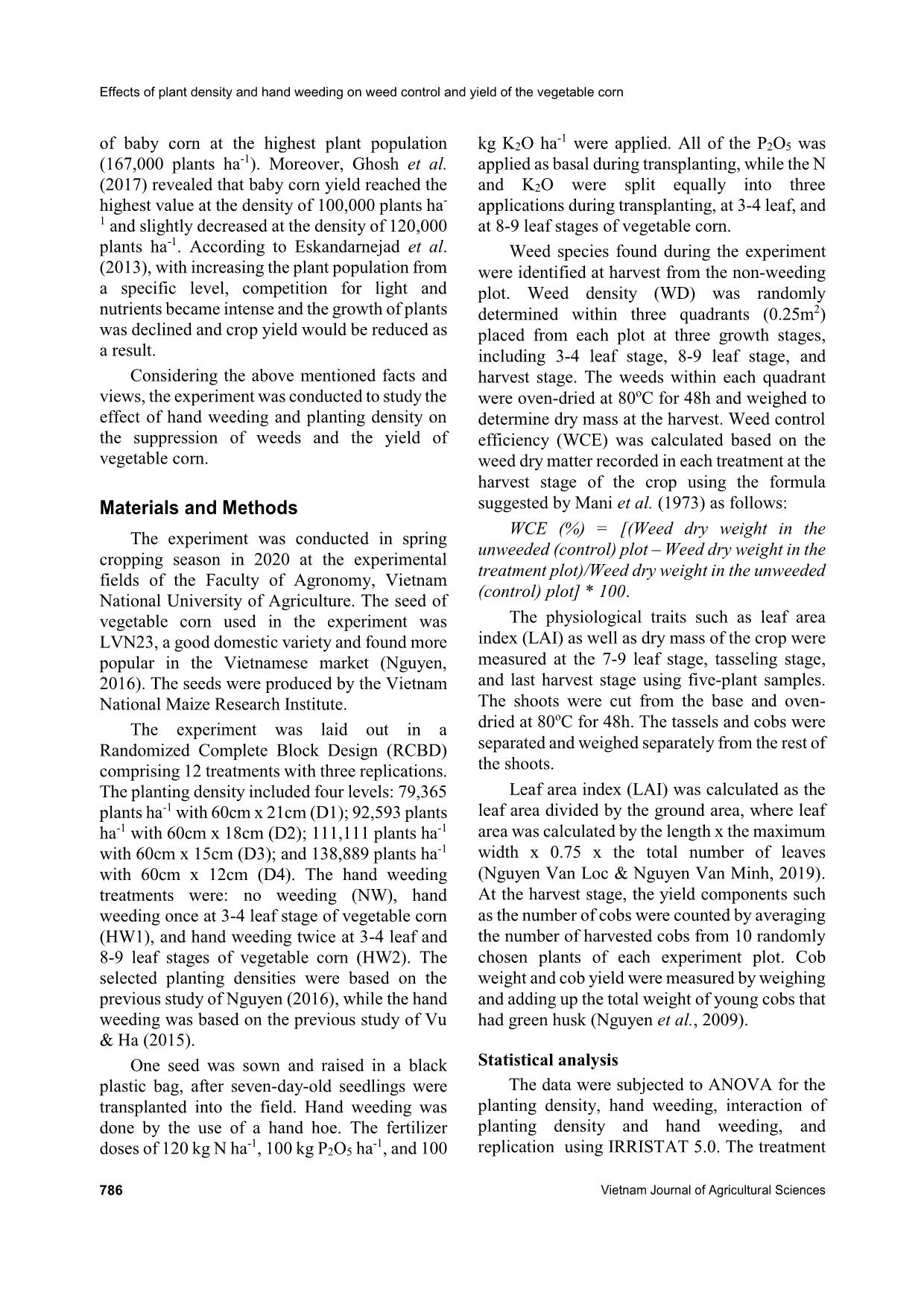
Trang 3
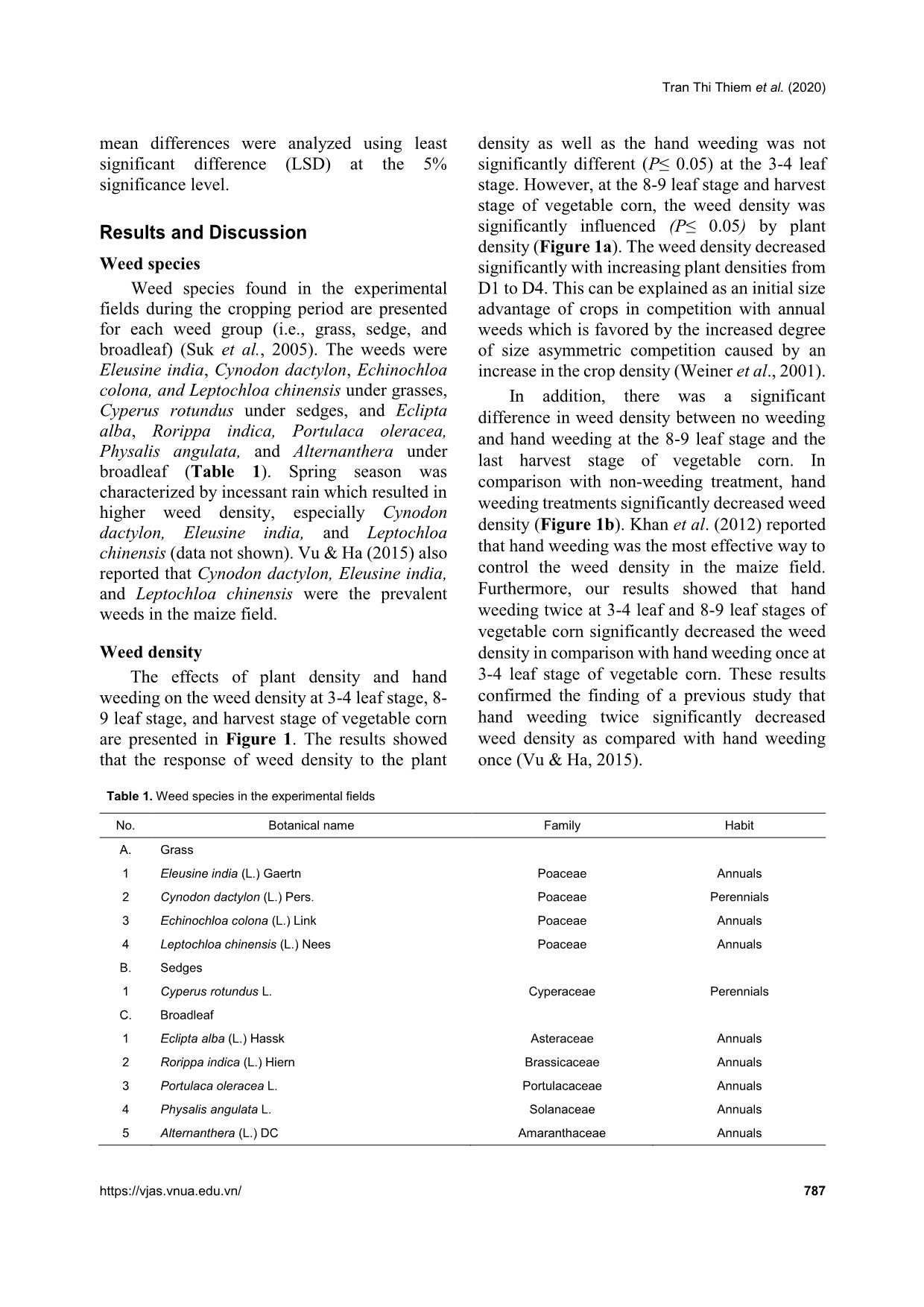
Trang 4
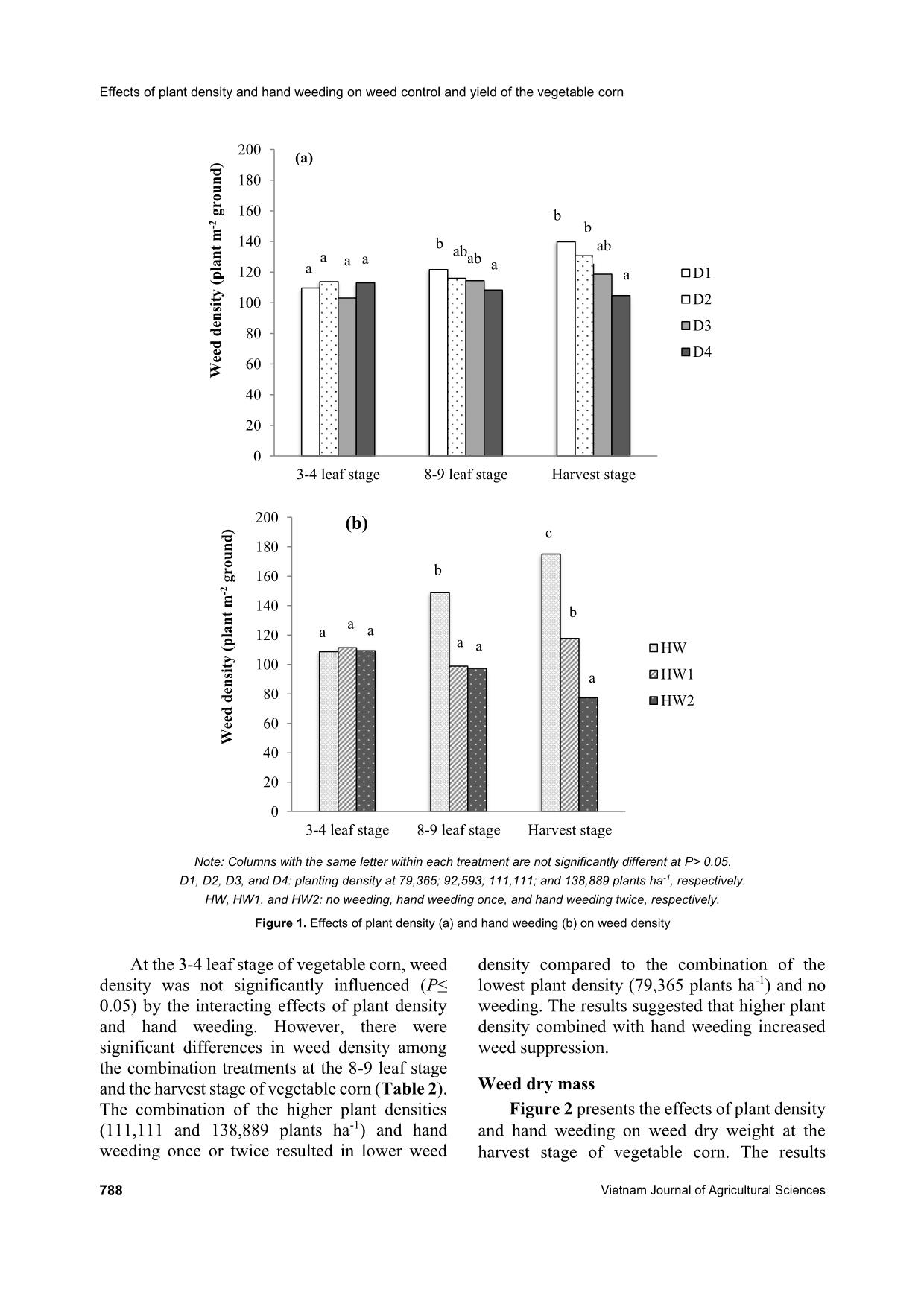
Trang 5
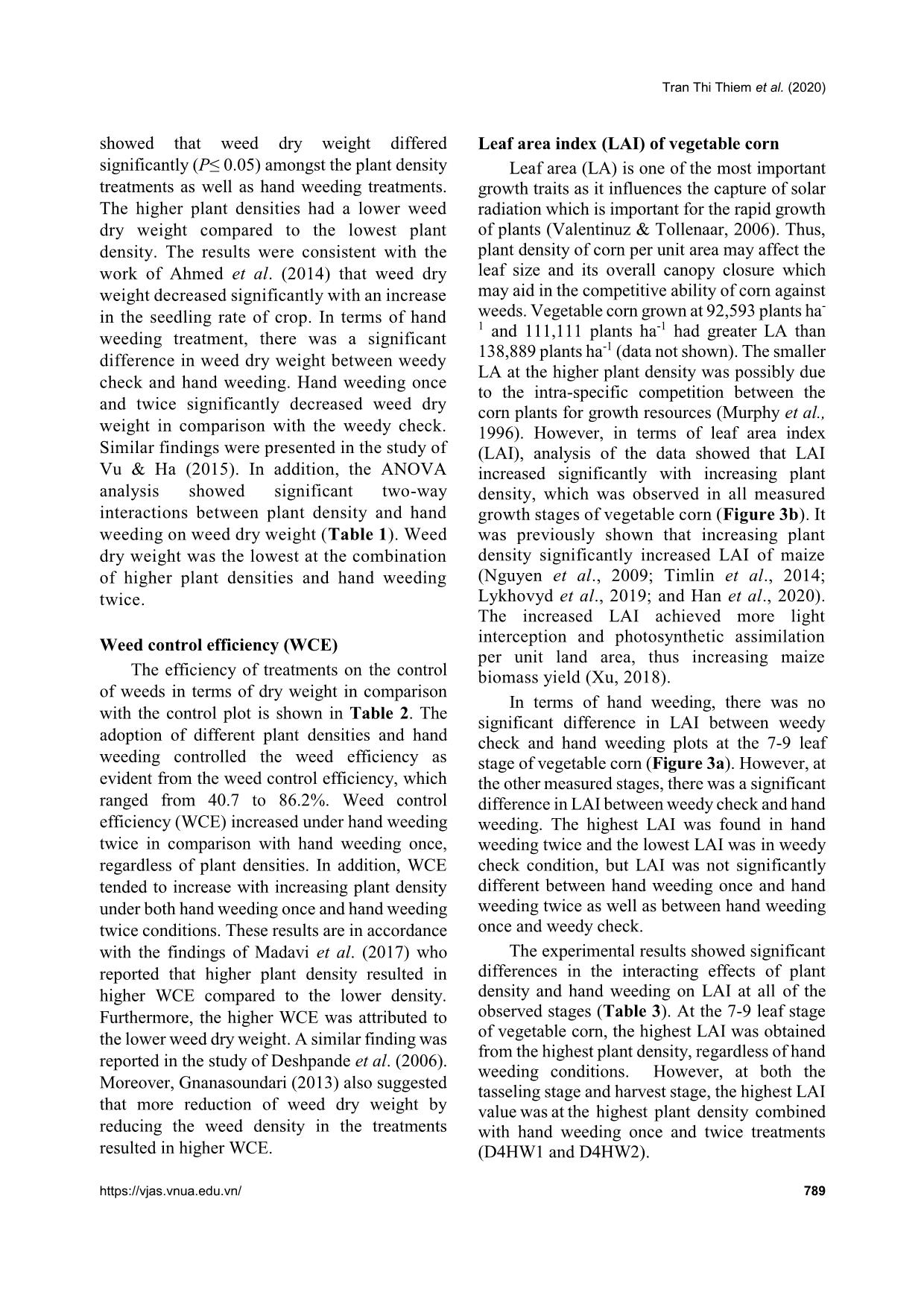
Trang 6
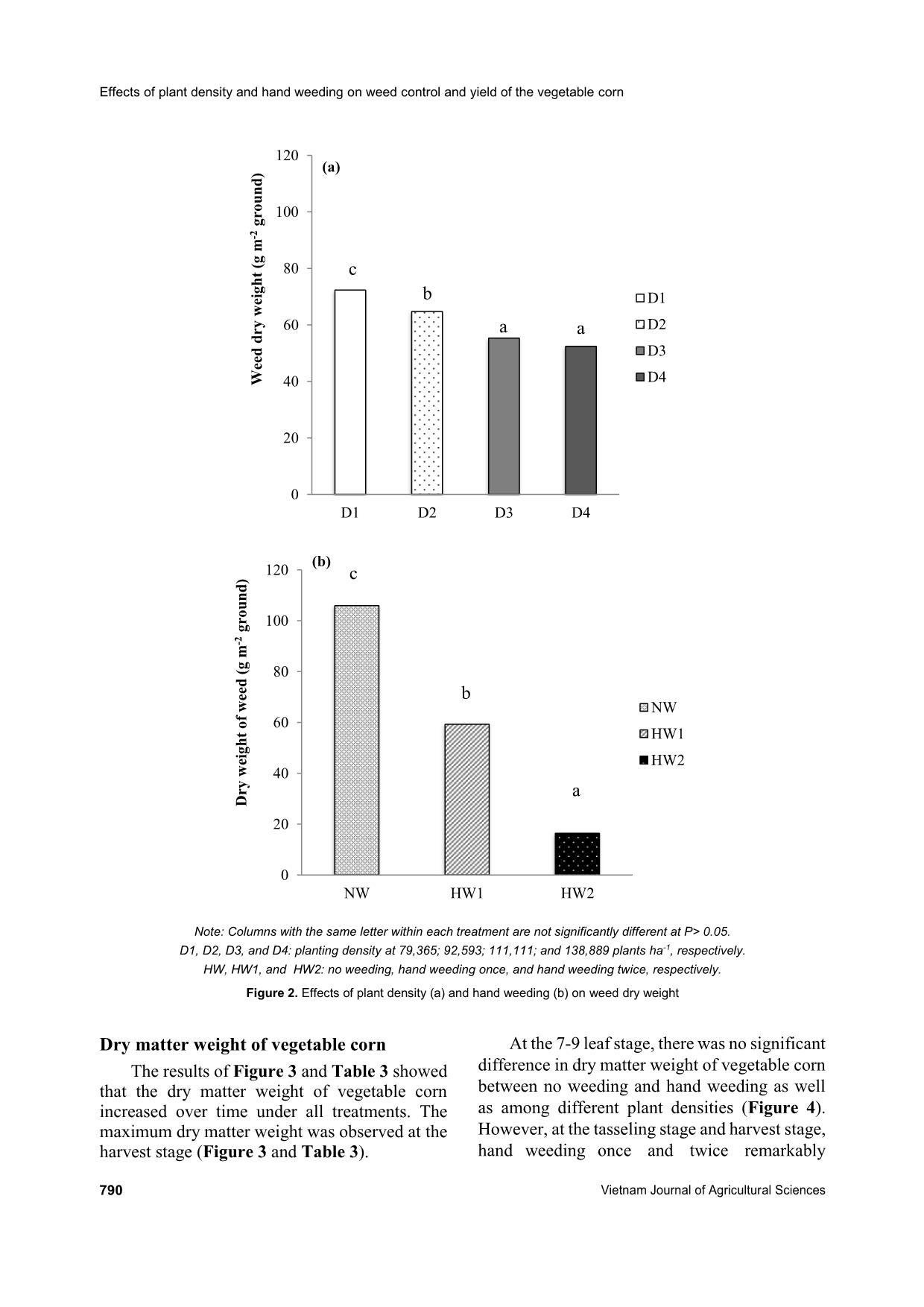
Trang 7
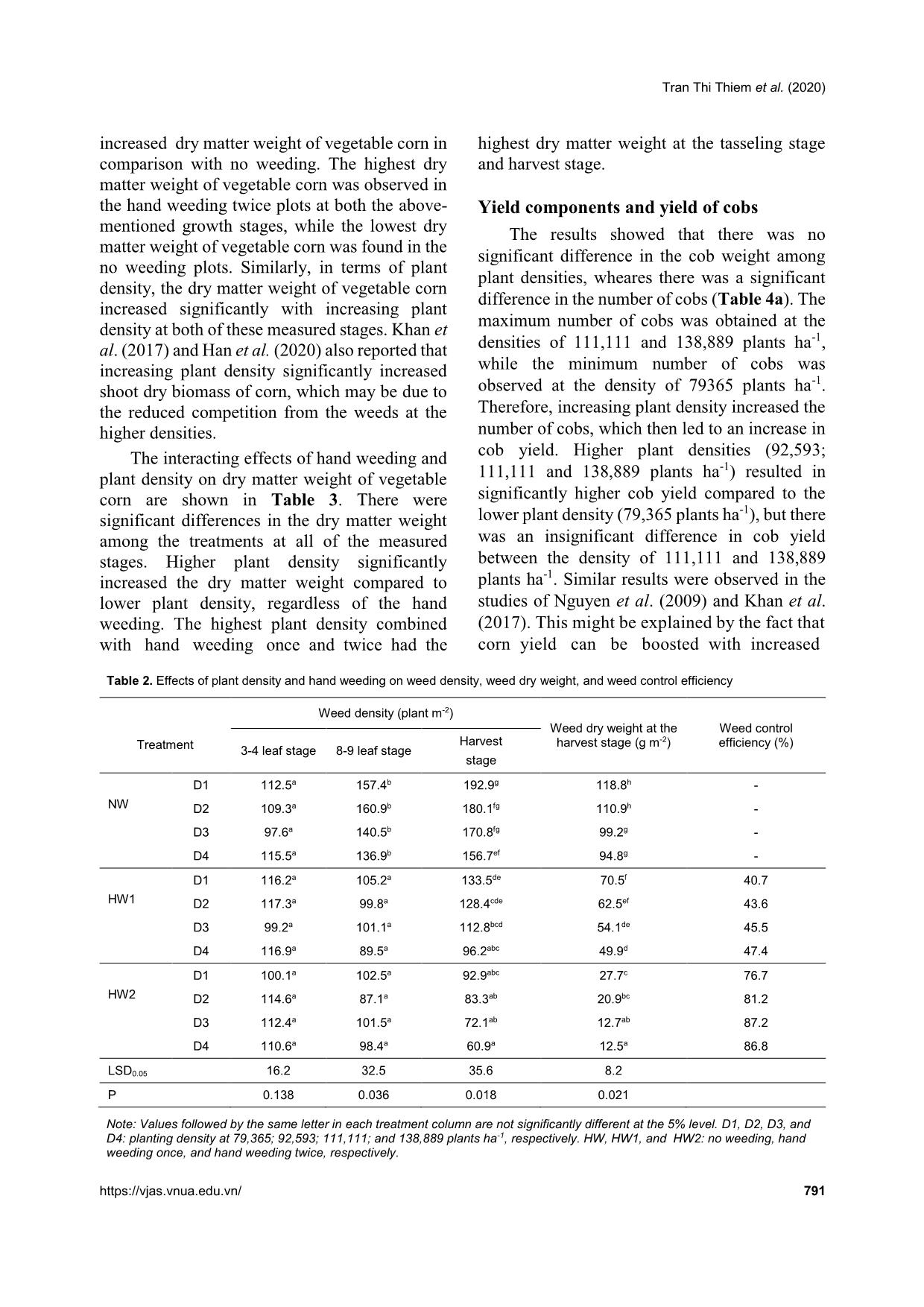
Trang 8
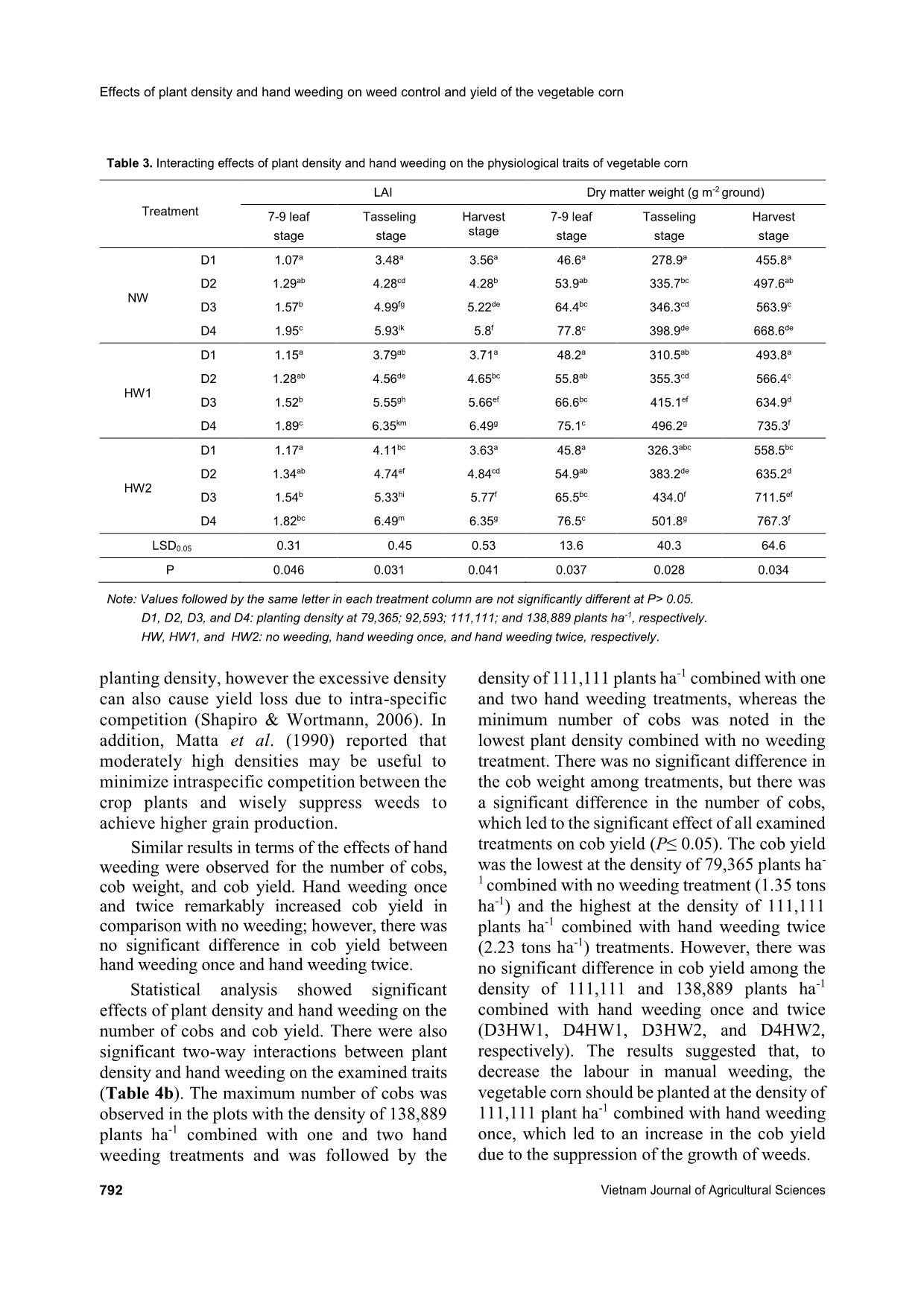
Trang 9
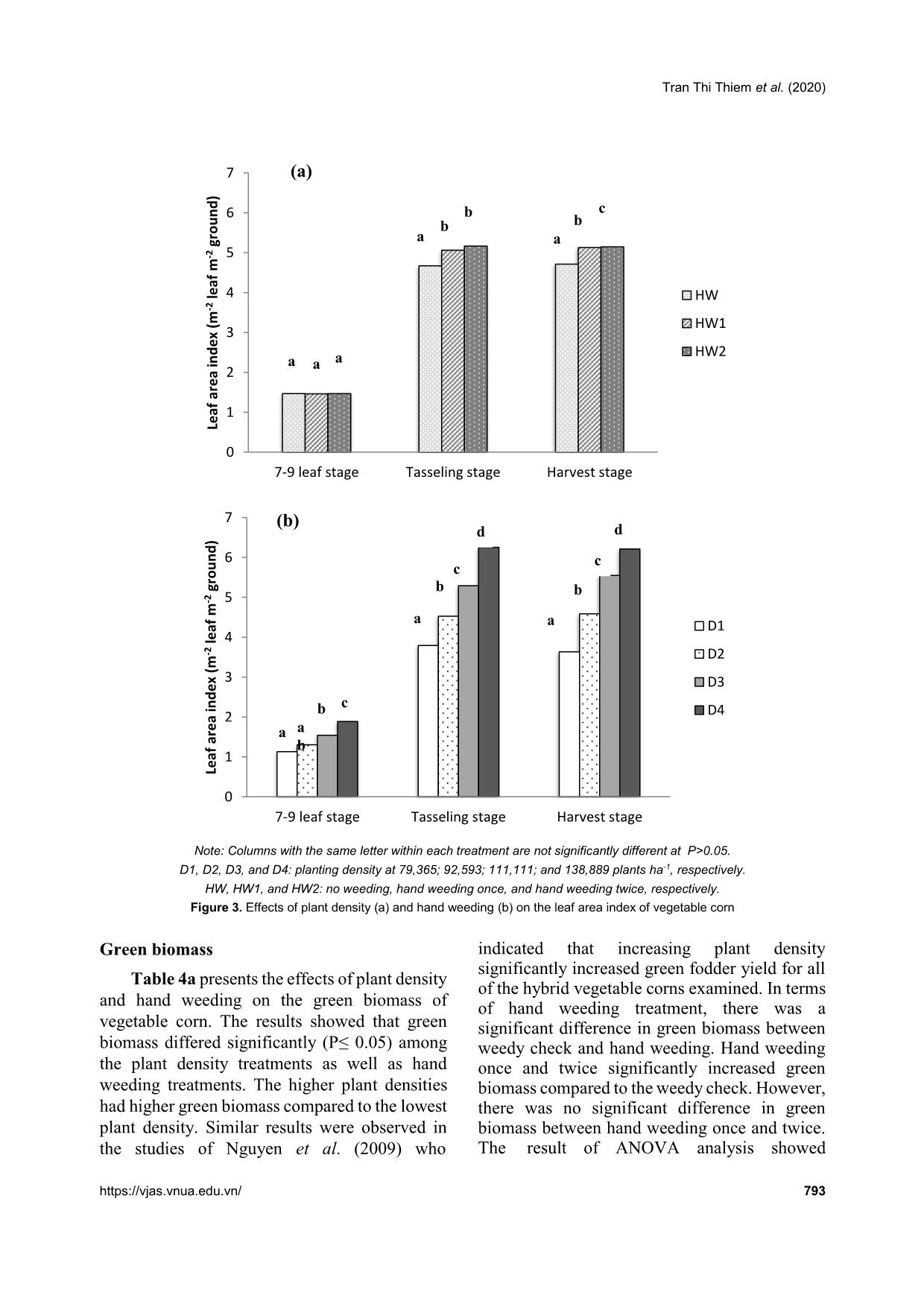
Trang 10
Tải về để xem bản đầy đủ
Tóm tắt nội dung tài liệu: Effect of plant density and hand weeding on weed control and yield of the vegetable corn
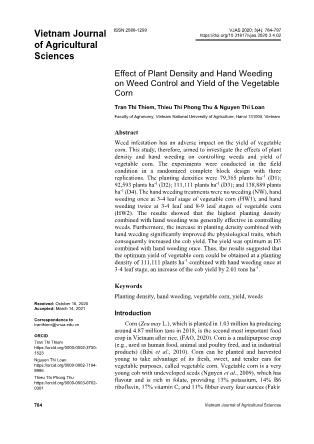
followed by the density of 111,111 plants ha-1 combined with one and two hand weeding treatments, whereas the minimum number of cobs was noted in the lowest plant density combined with no weeding treatment. There was no significant difference in the cob weight among treatments, but there was a significant difference in the number of cobs, which led to the significant effect of all examined treatments on cob yield (P≤ 0.05). The cob yield was the lowest at the density of 79,365 plants ha- 1 combined with no weeding treatment (1.35 tons ha-1) and the highest at the density of 111,111 plants ha-1 combined with hand weeding twice (2.23 tons ha-1) treatments. However, there was no significant difference in cob yield among the density of 111,111 and 138,889 plants ha-1 combined with hand weeding once and twice (D3HW1, D4HW1, D3HW2, and D4HW2, respectively). The results suggested that, to decrease the labour in manual weeding, the vegetable corn should be planted at the density of 111,111 plant ha-1 combined with hand weeding once, which led to an increase in the cob yield due to the suppression of the growth of weeds. Tran Thi Thiem et al. (2020) https://vjas.vnua.edu.vn/ 793 Note: Columns with the same letter within each treatment are not significantly different at P>0.05. D1, D2, D3, and D4: planting density at 79,365; 92,593; 111,111; and 138,889 plants ha-1, respectively. HW, HW1, and HW2: no weeding, hand weeding once, and hand weeding twice, respectively. Figure 3. Effects of plant density (a) and hand weeding (b) on the leaf area index of vegetable corn Green biomass Table 4a presents the effects of plant density and hand weeding on the green biomass of vegetable corn. The results showed that green biomass differed significantly (P≤ 0.05) among the plant density treatments as well as hand weeding treatments. The higher plant densities had higher green biomass compared to the lowest plant density. Similar results were observed in the studies of Nguyen et al. (2009) who indicated that increasing plant density significantly increased green fodder yield for all of the hybrid vegetable corns examined. In terms of hand weeding treatment, there was a significant difference in green biomass between weedy check and hand weeding. Hand weeding once and twice significantly increased green biomass compared to the weedy check. However, there was no significant difference in green biomass between hand weeding once and twice. The result of ANOVA analysis showed 0 1 2 3 4 5 6 7 7-9 leaf stage Tasseling stage Harvest stage Le af a re a in d e x (m -2 le af m -2 gr o u n d ) HW HW1 HW2 a aa b b a a c b (a) 0 1 2 3 4 5 6 7 7-9 leaf stage Tasseling stage Harvest stage Le af a re a in d e x (m -2 le af m -2 gr o u n d ) D1 D2 D3 D4b c c a c a b a d b a d b (b) Effects of plant density and hand weeding on weed control and yield of the vegetable corn 794 Vietnam Journal of Agricultural Sciences Note: Columns with the same letter within each treatment are not significantly different at P>0.05. D1, D2, D3, and D4: planting density at 79,365; 92,593; 111,111; and 138,889 plants ha-1, respectively. HW, HW1, and HW2: no weeding, hand weeding once, and hand weeding twice, respectively. Figure 4. Effects of plant density (a) and hand weeding (b) on the dry matter weight of vegetable corn significant two-way interactions between plant density and hand weeding on green biomass (Table 4b). The maximum green biomass was observed in the plots with the density of 138,889 plants ha-1 combined with one and two hand weeding treatments (32.22 and 32.36 tons ha -1, respectively), whereas the minimum green biomass was noted in the lowest plant density combined with no weeding treatment (18.78 tons ha-1). Conclusions The results showed that increasing the plant density combined with hand weeding once and twice suppressed the growth of weed, which then led to an increase in the yield of vegetable corn. 0 100 200 300 400 500 600 700 800 7-9 leaf stage Tasseling stage Harvest stage D ry m at te r w e ig h t (g m -2 gr o u n d ) HW HW1 HW2 a aa a bb a c b (a) 0 100 200 300 400 500 600 700 800 7-9 leaf stage Tasseling stage Harvest stage D ry m at te r w e ig h t (g m -2 gr o u n d ) D1 D2 D3 D4 a aaa a d c b a d c b (b) Tran Thi Thiem et al. (2020) https://vjas.vnua.edu.vn/ 795 Table 4a. Effects of plant density and hand weeding on yield components, cob yield, and green biomass of vegetable corn Treatment Number of cobs (1000 cobs ha-1) Cob weight (g plant-1) Cob yield (tons ha-1) Green biomass (tons ha-1) Hand weeding NW 270.19a 10.0a 1.53a 23.92a HW1 320.86b 10.2a 1.83b 25.94ab HW2 320.39b 10.2a 1.99b 26.42b LSD 0.05 41.9 1.5 0.18 2.45 P 0.043 0.132 0.043 0.034 Density D1 225.39a 9.7a 1.48a 19.67a D2 277.16b 9.7a 1.72b 23.07b D3 336.29c 10.3a 1.95c 26.98c D4 376.39c 10.8a 1.99c 31.98d LSD0.05 43.5 2.2 0.21 2.79 P 0.031 0.092 0.041 0.023 Note: Values followed by the same letter in each treatment column are not significantly different at P> 0.05. Table 4b. Interacting effects of plant density and hand weeding on yield components, cob yield, and green biomass of vegetable corn Treatment Number of cobs (1000 cobs ha-1) Cob weight (g plant-1) Cob yield (tons ha-1) Green biomass (tons ha-1) Hand weeding Density NW D1 196.03a 9.5a 1.35a 18.78a D2 255.56bc 9.8a 1.47ab 22.96bc D3 294.44cd 9.8a 1.61bc 25.67de D4 334.72de 9.4a 1.69bc 29.28fg HW1 D1 244.44b 9.8a 1.47ab 19.78ab D2 281.48bc 10.1a 1.71c 22.97cd D3 358.89ef 10.7a 2.01de 27.66ef D4 398.61f 10.2a 2.12de 33.36g HW2 D1 235.71ab 10.2a 1.61bc 20.46ab D2 294.45cd 11.2a 1.99d 24.27cd D3 355.56ef 10.9a 2.23e 27.63ef D4 395.83f 10.2a 2.15de 33.22g LSD0.05 46.5 2.7 0.23 3.04 P 0.042 0.15 0.037 0.023 Note: Values followed by the same letter in each treatment column are not significantly different at P> 0.05; D1, D2, D3, and D4: planting density at 79,365; 92,593; 111,111; and 138,889 plants ha-1, respectively. HW, HW1, and HW2: no weeding, hand weeding once, and hand weeding twice , respectively. The lower weed density and weed dry weight s were found at the higher plant density combined hand weeding twice treatment. Similarly, higher plant density combined with hand weeding resulted in higher cob yield compared to the lowest plant density combined with no weeding treatment. However, there was no significant difference in cob yield among the densities of 111,111 and 138,889 plants ha-1 combined with hand weeding once and twice. Therefore, the results suggested that under the lack of manual weeding labour condition, vegetable corn should be planted at the high density of 111,111 plants ha-1 combined with hand weeding once at 3-4 Effects of plant density and hand weeding on weed control and yield of the vegetable corn 796 Vietnam Journal of Agricultural Sciences leaves, which suppressed the growth of weed and obtained the high cob yield (2.01 tons ha-1). References Abouziena H. F., El-Karmany M. F., Sigh M. & Sharma S. D. (2007). Effect of nitrogen and weed control treatment on maize yield and associated weeds in sandy soil. Weed Technology. 21: 1049-1053. Ahmed S., Salim M. & Chauhan B. S. (2014). Effect of Weed Management and Seed Rate on Crop Growth under Direct Dry Seeded Rice Systems in Bangladesh. Plos One. 9(7): 1-10. Al-Samarai G. F., Mahdi W. M. & Al-Hilali B. M. (2018). Reducing environmental pollution by chemical herbicides using natural plant derivatieves – allelopathy effect. Annals of Agricultural and Environmental Medicine. 25(3): 449-452. Bibi Z., Khan N., Akram M., Khan Q., Khan M. J., Batool S. & Makhdum K. (2010). Integrating cultivars with reduced herbicides rates for weed management in maize. Pakistan Journal of Botany. 42(3): 1923-1929. Dalley C. D., Bernards M. L. & Kells J. J. (2006). Effect of weed removal timing and row spacing on soil moisture in corn (Zea mays). Weed Technology. 20(2): 399-409. Deshpande R. M., Pawar W. S., Mankar P. S., Bobde P. N. & Chimote A. N. (2006). Integrated weed management in rainfed cotton. Indian Journal of Agronomy. 51(1): 22-27. Dutta D., Thentu T. L. & Duttamudi D. (2016). Effect of weed- management practices on weed flora, soil micro-flora and yield of baby corn (Zea mays). Indian Journal of Agronomy. 61(2): 210-216. El-Sobky E. E. A. & El-Naggar N. Z. A. (2016). Effect of weed control treatment and planting density in Maize (Zea mays L.). Egyptian Journal of Agronomy. 38(1): 55-77. Eskandarnejad S., Khorasani S. S., Bakhtiari S. & Heidarian A. R. (2013). Effect of row spacing and plant density on yield and yield components of Sweet corn (Zea may L. Saccharata) varieties. Advanced Crop Science. 3(1): 81-88. Fakir M. S. A. & Islam M. A. (2008). Effect of planting density on morphological features and yield in “baby” corn. Journal of Agroforestry and Environment. 2(2): 9-13. Food and Agriculture Organization (FAO) (2020). FAOSTAT on crop production. Retrieved from on December 12, 2019. Gnanasoundari P. (2013). Weed management in organic rice production. M.Sc. (Ag.) Thesis. Tamil Nadu Agricultural University, Coimbatore. Ghosh M., Maity S. K., Gupta S. K. & Chowdhury A. R. (2017). Performance of baby corn under different plant densities and fertility levels in lateritic soils of eastern India. International Journal of Pure and Applied Bioscience. 5(3): 696-702. Han K., Liu B., Liu P. & Wang Z. (2020). The optimal plant density of maize for dairy cow forage production. Agronomy. 2020: 1-13. DOI: https://doi.org/10.1002/agj2.20004. Jia Q., Sun L. Mou H., Ali S., Liu D., Zhang Y., Zhang P., Ren X. & Jia Z. (2018). Effects of planting patterns and sowing densities on grain-filling, radiation use efficiency and yield of maize (Zea mays L.) in semi- arid regions. Agricultural Water Management. 201: 287-298. Khan N., Khan Z. & Khan A. (2017). Effect of maize planting densities on various growth parameters of barnyard grass. International Journal of Biology and Biotechnology. 14(1): 123-128. Khan M. A., Ali K., Hussain Z. & Afridi R. A. (2012). Impact of maize-legume Intercropping on weeds and maize crop. Pakistan Journal of Weed Science Research. 18(1): 127-136. Khanh T. D., Trung K. H., Anh L. H. & Xuan T. D. (2018). Allelopathy of barnyardgrass (Echinochloa crus-galli) weed: an allelopathic interaction with rice (Oryza sativa). Vietnam Journal of Agricultural Sciences. 1(1): 97-116. Kotru R., Singh L., Singh P., Quayoom S., Sing K. N. & Ahmad L. (2012). Growth and yield of baby corn (Zea mays L.) as influenced by sowing dates and weed management practices under temperate condition. Haryana Journal of Agronomy. 28(1&2):11-18. Kumar B., Prasad S., Mandal D. & Kumar R. (2017). Influence of integrated weed management practices on weed dynamics, productivity and nutrient uptake of Rabi maize (Zea mays L.). International Journal of Current Microbiology and Applied Sciences. 6(4): 1431-1440. Kumawat N., Yadav R. K., Bangar K. S., Tiwari S. C., Morya J. & Kumar R. (2019). Studies on intergrated weed management practices in maize - A review. Agricultural Reviews. 40(1): 29-36. Lykhovyd P. V., Ushkarenko V. O., Lavrenko S. O., Lavrenko N. M., Zhuikov O. H., Mrynskyi I. M. & Didenko N. O. (2019). Leaf area index of sweet corn (Zea mays ssp. Saccharat L.) crops depending on cultivation technology in the drip – irrigated conditions of the south of Ukraine. Modern Phytomorphology. 13(1-4): 1-5. Madavi B., Leela Rani P., Sreenivas G. & Surekha K. (2017). Effect of High Density Planting and Weed Management Practices on Weed Drymatter, Weed Indices and Yield of Bt Cotton. International Journal of Pure and Applied Bioscience. 5(4): 1945-1950. Mani V. S., Mala M. L., Gautam K. C. & Bhagavandas (1973). Weed-killing chemicals in potato cultivation. India Farming. 23: 7-13. Marín C. & Weiner J. (2014). Effects of density and sowing pattern on weed suppression and grain yield in three Tran Thi Thiem et al. (2020) https://vjas.vnua.edu.vn/ 797 varieties of maize under high weed pressure. Weed Research. 54(5): 467-474. Matta S. E. G., Khedr E. A. F., Mehgoub G. M. A. & Shelby M. A. K. (1990). Effect of plant population density and nitrogen fertilization on growth and yield of some late maturing maize variety. Egyptian Journal Applied Science. 5(8): 519-532. Murphy S. D., Yakubu Y., Wise S. F. & Swanton C. J. (1996). Effect of planting patterns and inter-row cultivation on competition between corn (Zea mays) and late emerging weeds. Weed Science. 44: 865-870. Nguyen V. L., Nguyen T. H., Nguyen V. L, Dinh T. H. & Nguyen T. N. (2009). Effects of different plant densities on yield and quality of hybrid baby corn. Journal of Science and Development. 7 (Eng. Iss. 2): 202-208. Nguyen V. L. (2016). Study on growth, yield and heterosis of vegetable corn hybrids. Vietnam Journal Agricultural Science. 14(4): 501-509. Nguyen Van Loc & Nguyen Van Minh (2019). Using organic pots and granulated compound fertilizer application for HN88 waxy maize variety. Tay Nguyen Journal of Science. 39: 38-47 (in Vietnamese). Shapiro C. A. & Wortmann C. S. (2006). Corn response to nitrogen rate, row spacing and plant density in Eastern Nebraska. Agronomy Journal. 98: 529-535. Suk J. K., Yong W. K., Duong V. C. & Hoang A. C. (2005). Common weeds in Vietnam (2nd ed.). Saigon Plant Protection State Limited Company. Timlin D. J., Fleisher D. H., Kemanian A. R & Reddy V. R. (2014). Plant density and leaf area index effects on the distribution of light transmittance to the soil surface in Maize. Agronomy Journal. 106(5): 1828-1837. Valentinuz O. R. & Tollenaar M. (2006). Effect of genotype, nitrogen, plant density and row spacing on the area per leaf profile in maize. Agronomy Journal. 98: 94-99. Vu D. H. & Ha T. T. B. (2015). Effect of maize-soybean intercropping and hand weeding on weed control. Journal of Science and Development. 13(3): 354-363. Weiner J., Griepentrog H. W. & Kristensen L. (2001). Suppression of weeds by spring wheat (Triticum aestivum) increases with crop density and spatial uniformity. Journal of Applied Ecology. 38: 784-790. Youngerman C. Z., Tommaso A. D., Curran W. S., Mirsky S. B. & Ryan M. R. (2018). Corn density effect on interseeded cover crops, weeds and grain yield. Agronomy. 110(6): 2478-2488.
File đính kèm:
 effect_of_plant_density_and_hand_weeding_on_weed_control_and.pdf
effect_of_plant_density_and_hand_weeding_on_weed_control_and.pdf

